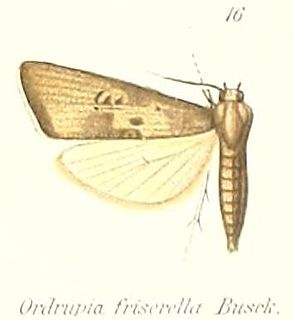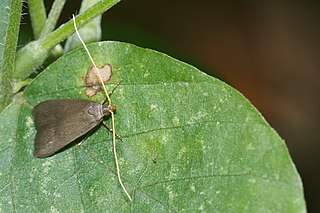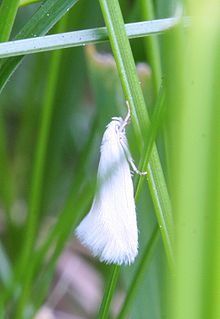Related Research Articles

The Elachistidae are a family of small moths in the superfamily Gelechioidea. Some authors lump about 3,300 species in eight subfamilies here, but this arrangement almost certainly results in a massively paraphyletic and completely unnatural assemblage, united merely by symplesiomorphies retained from the first gelechioid moths.

Gelechioidea is the superfamily of moths that contains the case-bearers, twirler moths, and relatives, also simply called curved-horn moths or gelechioid moths. It is a large and poorly understood '"micromoth" superfamily, constituting one of the basal lineages of the Ditrysia.

Copromorphidae, the "tropical fruitworm moths" is a family of insects in the lepidopteran order. These moths have broad, rounded forewings, and well-camouflaged scale patterns. Unlike Carposinidae the mouthparts include "labial palps" with the second rather than third segment the longest. With other unusual structural characteristics of the caterpillar and adult, it could represent the sister lineage of all other extant members of this superfamily. The genus Sisyroxena from Madagascar is also notable for its unusual venation and wing scale sockets.

The Plutellidae are a family of moths commonly known as the diamondback moths, named after the diamondback moth of European origin. Some authors consider this family to be a subfamily of the Yponomeutidae, but it is usually considered to be a family in its own right, and have three subfamilies, Plutellinae, Praydinae, and Scythropiinae.

The Lecithoceridae, or long-horned moths, are a family of small moths described by Simon Le Marchand in 1947. Although lecithocerids are found throughout the world, the great majority are found in the Indomalayan realm and the southern part of the Palaearctic realm.
Prototheora is a genus of moths. It is the only genus of the Prototheoridae, or the African primitive ghost moths, a family of insects in the lepidopteran order, contained in the superfamily Hepialoidea. These moths are endemic to Southern Africa.

Dichomeris is a genus of moths in the family Gelechiidae erected by Jacob Hübner in 1818.
Helcystogramma is a genus of moths in the family Gelechiidae. The genus was erected by Philipp Christoph Zeller in 1877.

The Lecithocerinae are a subfamily of small moths in the family Lecithoceridae. They are found worldwide, but most species occur in South Asia. The subfamily is characterized by the male genitalia with a bridge-like structure connecting the tegumen and the valva, and the uncus almost always is vestigal with two lobes at the dorsal base, only exceptionally united into a broad plate, but never as a thorn or spine.

Udea is a genus of snout moths in the subfamily Spilomelinae of the family Crambidae. The genus was erected by Achille Guenée in 1845. The currently known 214 species are present on all continents except Antarctica. About 41 species are native to Hawaii.

Lecithocera is a genus of moths in the lecithocerid subfamily Lecithocerinae. The genus was erected by Gottlieb August Wilhelm Herrich-Schäffer in 1853.
Torodora is a genus of moths in the family Lecithoceridae. The genus was erected by Edward Meyrick in 1894.

Macrobathra is a genus of moths in the family Cosmopterigidae. Most species are endemic to Australia.

Elachista is a genus of gelechioid moths described by Georg Friedrich Treitschke in 1833. It is the type genus of the grass-miner moth family (Elachistidae). This family is sometimes circumscribed very loosely, including for example the Agonoxenidae and Ethmiidae which seem to be quite distinct among the Gelechioidea, as well as other lineages which are widely held to be closer to Oecophora than to Elachista and are thus placed in the concealer moth family Oecophoridae here.

Autosticha is a genus of gelechioid moths. It belongs to the subfamily Autostichinae, which is either placed in the concealer moth family (Oecophoridae), or in an expanded Autostichidae. It is the type genus of its subfamily. Originally, this genus was named Automola, but this name properly refers to a fly genus in family Richardiidae.

Xyloryctidae is a family of moths contained within the superfamily Gelechioidea described by Edward Meyrick in 1890. Most genera are found in the Indo-Australian region. While many of these moths are tiny, some members of the family grow to a wingspan of up to 66 mm, making them giants among the micromoths.

Gracillariinae are a subfamily of moths which was described by Henry Tibbats Stainton in 1854.

The Stenomatinae are a subfamily of small moths in the family Depressariidae.
Mnesteria basanistis is a moth in the family Lecithoceridae. It was described by Edward Meyrick in 1908. It is found in Sri Lanka.
Mnesteria pharetrata is a moth in the family Lecithoceridae. It was described by Edward Meyrick in 1905. It is found in Sri Lanka.
References
| This article relating to the subfamily Lecithocerinae is a stub. You can help Wikipedia by expanding it. |